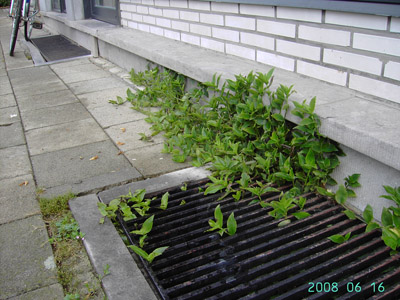1. Tradescantia fluminensis Vell. (S-Am.) – A rare escape from cultivation. Probably first collected on a canal bank in Doornzele in 1988 (as Commelina communis). Obviously much increasing since the early 2000’s, especially in urban areas that are more or less protected from frostbite, for instance in Antwerpen and Gent (and doubtlessly overlooked in other large cities). Tradescantia fluminensis usually grows on basement walls, foot of walls,… In a few localities it is very persistent and seems more or less naturalised, for instance on Antwerpen-Linkeroever. It apparently easily survived the successive cold winters of 2008-2009 and 2009-2010. It is a possible candidate for a future, wider naturalisation in urban habitats.
Non-flowering plants of Tradescantia fluminensis and Commelina communis are much alike and could occur in the same urban habitats. Tradescantia fluminensis is a perennial with rather small leaves (ca. 2,5-5 x 1-2 cm) with ciliolate margins whereas Commelina communis is an annual with larger leaves (ca. 5-12 x 1-4 cm) with glabrous margins.

 |
 |
 |


